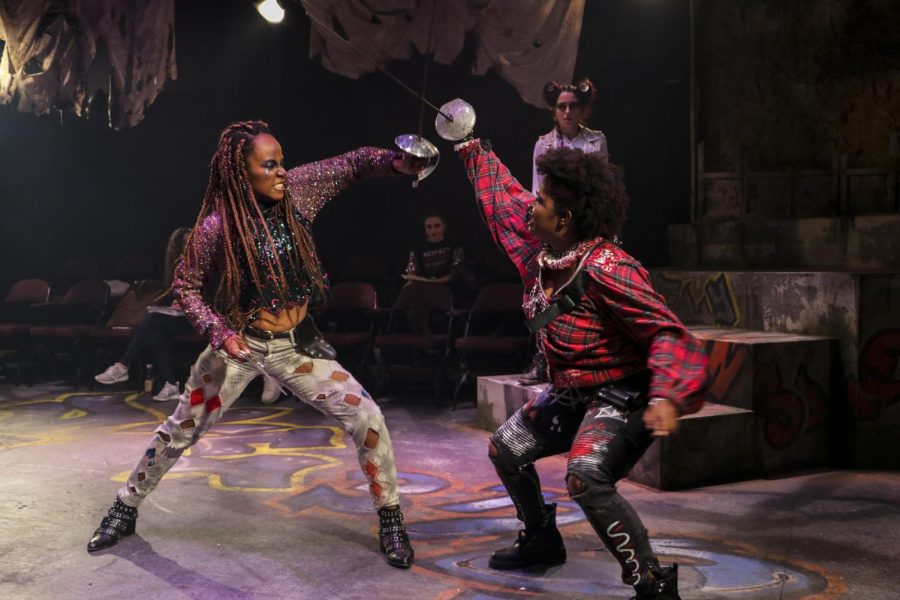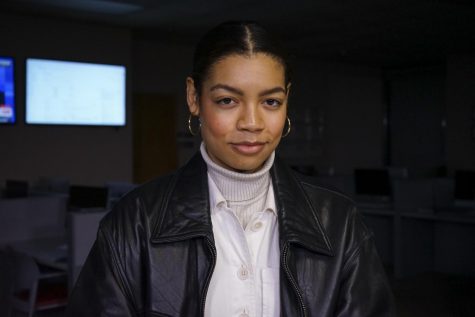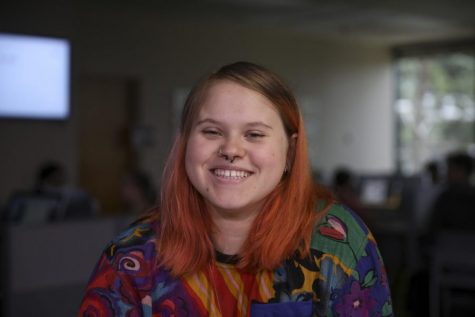Theater students allege typecasting, exclusion of students of color, department promises change
Talia Moore (right), A’20, performs a fight scene as Mercutio in Romeo & Juliet in 2019. Moore was one of several theater students of color who said they felt typecast in the department’s productions, but her role as Mercutio in “Romeo and Juliet” was one of the first opportunities she was able to play a non-traditional Black role.
July 13, 2020
The death of George Floyd and the resulting Black Lives Matter protests have catalyzed students in Loyola’s Theater Arts and Dance Department to come forward with allegations of typecasting in productions, having a European-based curriculum and ignoring students of color within its community.
The dean of Loyola’s College of Music and Media, Kern Maass, said the university has only been made aware of the concerns within the last few weeks, and he is in communication with the chair of the department, Patrick Gendusa, and students to address the concerns.
The Maroon spoke with six current and former students in the theater department who claimed they knew about or have experienced what they felt was racism during their time in productions and in the classroom.
On June 2, 2020 a group of theater students individually wrote five-page letters to University President Tania Tetlow, the Black Student Union, and the Student Government Association to express what they felt were experiences of racism within the theater department, said senior theater student, Breland Leon, who is Black.
President Tetlow held a June 11 town hall to address the entire student body about racism allegations happening on campus.
The next day, chairman of the department, Patrick Gendusa, who is white, and a group of eight to 10 theater students held a meeting to discuss the allegations. President Tetlow had previously scheduled meetings and was unable to attend, according to Leon.
Maass said Gendusa’s first semester as the head of the department was in September 2019, and he inherited all shows, faculty and curriculum plans already scheduled for that school year.
In the meeting, Leon said Gendusa apologized on the behalf of the theater department to students who felt a lack of inclusion in the community.
“I had a wonderful three-hour Zoom meeting with many of the students of color last week. It was a first step and the first of many open dialogues that we will all have. They need to and will be heard,” said Gendusa.
Following the meeting, Gendusa posted a statement on the theater department’s Instagram page addressing all students.
“We will work in solidarity with students to create an anti-racist, equitable and inclusive learning/performance space where all can thrive,” the statement said.
Maass said the College of Music and Media “is taking a holistic approach for all faculty, staff and students — not just the department of Theater Arts & Dance. I imagine this may take many forms from required workshops for faculty and staff to conversations with faculty and students that happen at the college, school, and department level,” said Maass.
All six students who spoke with The Maroon said that they felt there was a suppression of student voices, stemming from a largely white and European-based curriculum.
“There are subtle things that go on in the theater department, that even those who are doing it don’t even know they are doing it, and I think it is because there aren’t a lot of people of color, and we go to a (predominantly white institution),” said junior theater student, Jada Williams, who is Black.
Along with Williams, four other students said that the class, Black Theatre, made them uncomfortable because it was taught by a white woman, who resigned this past semester.
“Why are we being taught stuff that was traumatic for us by somebody who cannot personally relate to this history?” said Williams.
Gendusa said the university has now hired Sherri Marina, a Black woman, who will serve as the new professor of the class moving forward and the course will cover material from the 1940s to present day.
The department is also hiring Kai Knight, a black woman, in a permanent position as the instructor of the new African/Modern fusion dance course. There will also be a Latin Theatre course offered in the Spring, said Gendusa.
Leon said he first felt an “intimidation factor” at the theater department’s orientation and in class during his freshman year in 2015, and it was that feeling that he said likely discouraged himself and other students of color from coming forward about uncomfortable experiences.
All six students said they felt that white professors and students often comment on racial issues on a “surface-level.” Senior theater student, Caitlyn Ritchie, who is white, said that theater surrounding people of color “is told through a very stereotypical lens.”
Students said that the department’s productions about the Black experience often only cover civil rights issues and that students of color are often typecast in plays.
“Anyone who is supposed to be a Black character will be cast as that Black character. However, I’ve noticed that you’ll also have characters that are white and solely white … it feels like typecasting,” said sophomore theater student, Ryan Wiles, who is Black.
In the fall of 2019, Wiles performed alongside Williams in “You Can’t Take It With You,” a comedy play that centers around two white families.
There were four students of color in the cast. Wiles played a father, who was the suitor of the daughter of a white family. Williams acted as one of two servants. The other servant was also played by a Black student.
“You have to convince yourself that it’s OK to be in these kinds of roles because the minute I saw what they were calling me back for, it made me feel less than inadequate and people assumed that it was what I was being treated as on stage,” said Williams.
According to Leon, the department had to make changes to the script of that show due to what he said were racist undertones in several lines.
“I saw it on closing night, and it was a room of an older white audience, as well as some students from UNO’s theater department. The older white audience laughed heavily at the racial microaggressions, the butt of the jokes against the people of color,”said Leon.
Talia Moore, A’20, who is Black, said that upperclassmen who graduated before her warned her that the department had a “bad habit” of casting the same people in the same roles due to “moderate racism.”
As a freshman, Moore performed in “The House That Will Not Stand,” and “Carolina, or Change” her sophomore year, which were productions centered around the Black experience.
Moore also played Mercutio in Shakespeare’s “Romeo and Juliet,” which she said “was unlike anything I’ve ever been casted as because I got to be somebody different.”
In response to these student comments, Gendusa said the university is working to diversify the stories it tells about people of color.
In the coming semester, Lauren Turner, a Black producing artistic director of the No Dream DeferredNOLA Theater Company, will guide and educate the theater department as a trained equity, diversity, and inclusion facilitator, said Gendusa.
“Our goal is to create a meaningful, lasting and permanent change to how we approach our work, see the world, and understand one another,” said Gendusa.
In fall, the theater department plans to produce “Cadillac Crew,” which re-tells stories of forgotten leaders that fought for desegregation and women’s rights. Gendusa said the play will be produced by a professor of color, who has not yet been named.
In the spring, Gendusa said the department will also be producing “Stop Kiss,” which is a play about a homophobic assault that “tests the love between two women.”
“We are in the progress of establishing collaborative relationships with several theater companies whose mission is diversity and focus on people of color. We will begin open dialogues with our students, our community, and create bold new works,” said Gendusa.
Leon and Williams said that they feel white students and faculty do not notice what students of color have said was racism within the department because it is benefiting and not affecting them, and that they, as students of color, feel ignored in the community.
“Everybody tries to excuse it, water it down, make it seem like it wasn’t that. But I’m sorry, I was only called back for the role of the mammy,” said Williams, about her role in the show “You Can’t Take It With You.”
Theater students, Shelbi Copain and Madeline Taliancich, manage the department’s Instagram page, and they created an allyship group chat after students brought up concerns back in May of 2020 for students of color to share ideas, resources and helpful information.
“Now that the theater world isn’t functioning in the way we’re used to, and the two of us had time to prioritize and plan posts besides production advertisements, we wanted to give social justice a greater focus than we’d previously been able to,” Taliancich, who is white, said of the chat.
Leon said that white students need to address what he said was a lack of photos and accomplishments by students of color on the department’s Instagram account.
“The reason there has not been a lot of content social justice related on our page is simply because that was not a mission,” Copain, who is white, said in the allyship chat.
Leon and several students said they were confused about why recognizing the accomplishments of backstage crew and alumni, particularly people of color, was a “social-justice issue.”
“Even if the cast is all white, there are a bunch of backstage people who are also people of color and deserve recognition, but so much emphasis gets put on casts instead of crews,” said Sophomore Ti Zampino, who is white.
“One of the students in the group chat suggested having students of color every now and then do Instagram takeovers to spread awareness of issues. I’d also love to start doing more artist spotlights in which we post graphics about queer artists, artists of color, female artists, etc. to help bring awareness to the awesome people who help make theater happen, even when it can’t in a pandemic,” said Taliancich.
“Because our page’s primary focus is promoting shows, I am hoping these changes will give everyone the opportunity to feel represented because the shows we cover will be more fairly cast, and more diverse in general,” said Copain.
Gendusa said he offered all students a platform to communicate their concerns and make them feel heard.
On June 1, Gendusa wrote in an email saying, “I am happy to chat with students one-on-one via phone or Zoom,” according to an email obtained from Leon.
But Leon said the offer felt as though Gendusa was unwilling to confront all students who felt frustrated and ignored.
“He would only talk to us one-on-one through Zoom or phone call. That avoided us having an actual conversation where you would acknowledge us as a mass and see that it is a collective issue among the people of color, within the department,” said Leon.
BSU President Brionna Adams, said that the organization recognizes theater students’ concerns, especially students of color, and BSU will help with facilitating meetings, promoting any events, and connecting with outside organizations.
When asked why the department is only taking action on students’ concerns now instead of in the past, Gendusa said, “Many of the students’ concerns had been or were being addressed prior to sharing their concerns with me. That had not been well communicated.”
Gendusa said he is excited “to become a leader in acknowledging the call for change.”
“One of the glorious things that has happened as a result of the recent tragic events is that our students of color now feel empowered to speak up and voice their concerns. I am so proud of them and grateful that they are sharing their powerful, heartfelt voices and allowing me the opportunity to listen. I have always said that I cannot help you with a problem if I am not aware of it,” said Gendusa.
Students of color said they hope the department will acknowledge their concerns, and they will also have equal opportunities to white students in the future.
“At its core, theater is storytelling, and it is supposed to reflect the society that we live in, the values, and the struggles. To collaborate in this way, I think we’re doing nothing but furthering that beautiful tradition that we’ve had for thousands of years,” said Moore.










Alum '07 • Jul 20, 2020 at 2:18 pm
Why is the entire theatre department getting such an easy pass for this??? Shouldn’t they all be fired?
Just amazing that there is a whole witch hunt going on over Walter Block’s academic and scholarly research while the theater department type casts people by the color of their skin and only gets a slap on the wrist and a “try harder” next semester response.
Also, don’t see how this is any less bad than the communications professor that went to ASU….maybe even worse.